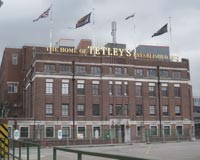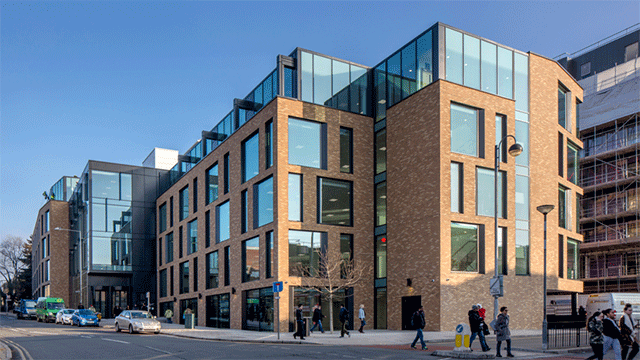Under the dark arches of the railway line, across the River Aire and the busy roads, this is the best route for most visitors arriving at Leeds station to access what the council has branded the city’s “South Bank”.
It is actually very close to the rest of Leeds’ compact centre, but miles away in the perception of many. It is a run-down area, patchily developed, and dominated by the Tetley brewery, which ceased production in June after almost 190 years.
The council and local landowners have identified around 40 acres for regeneration and, earlier this month, the council unveiled its South Bank Planning Statement – a blueprint for the district’s redevelopment.
The document lists offices, hotels, conferences and educational facilities, plus convenience retail and bars and restaurants as potential uses, alongside flats and family homes.
The local authority hopes that more than 9,000 homes and premises for 40,000 jobs will be created. “We’ve tried to write a framework that is durable in different market conditions, but which has a number of key components,” explains Phil Crabtree, the council’s chief planning officer.
It will need to be as this is a 20-year project to create a quarter for the city. The overall development will be several million square feet.
Commercial sites
The South Bank comprises three major commercial sites; the 22-acre Carlsberg Tetley brewery, 7.7 acres of dated offices and industrial space owned by Northern Ireland-based developer McAleer & Rushe on New Lane, and supermarket giant Asda’s UK corporate headquarters.
Development will be based around a city park, proposed by the council, to which developers will be expected to contribute 20% of their sites. It will be centred on council-owned land surrounding Meadow Lane.
Local agents see the South Bank as a valid proposal, but at a more favourable point in the cycle. Quizzed on what the landowners should aim to build, Savills planning director Richard Serra says: “The mix of uses is secondary to the timing.”
Others argue that the area immediately south of the station is no stranger to corporate occupiers, and cite the council’s recent deal to build 60,000 sq ft of offices for KPMG at nearby Sovereign Street as an example of occupier interest.
However, this site has history. The council has had ambitions for Sovereign Street since 2004 when Simon Estates won a council-run design competition.
High hopes
Yet hopes remain high. Alex Munro, partner with Knight Frank and agent for McAleer & Rushe, is quick to point out that rents of £27 per sq ft were achieved at the height of the market at the 230,000 sq ft Bridgewater Place, adjacent to the New Lane site.
While he acknowledges that such a level is unlikely to be matched in the next cycle, Munro says: “It will certainly reach the mid-£20s per sq ft.”
To achieve all this, redevelopment of the brewery will be vital. Carlsberg Tetley has appointed Arup to determine the site’s future, and the search for a developer to partner the drinks conglomerate, or to buy the land outright, will be launched next year.
In the meantime, the company is about to submit plans for temporary uses for the brewery – including car parking, an arts venue and green space – which could be in place for up to five years.
Arup’s Richard Bickers explains that the task of masterplanning will begin once a developer is on board, hopefully by the end of 2012. He says: “The West End of Leeds is distinctly an office area, while Holbeck is identified as a sustainable urban village. We have more of a challenge; we want a greater variety of uses.”
McAleer & Rushe plans a hotel and office development with floorplates of at least 20,000 sq ft. Leases on the site begin to expire in two and a half years’ time and the firm aims to submit an outline planning application in 2012.
Stephen Davey, of McAleer & Rushe, says: “Our site will be one of the first elements to come forward, and it will be a phased development.”
It is unlikely that Asda will play an active role in the foreseeable future. In a statement, Asda said it is working with the council on its aspiration for the South Bank, but has no plans to relocate from its offices.
Observers say the supermarket chain is taking part in the exercise to keep all options open.
A major upgrade of the area’s infrastructure will be crucial to the scheme’s success.
Network Rail has secured £15m to create a southern entrance to Leeds station by the end of 2013, alleviating the need for walks beneath its dark arches.
A more distant prospect is the proposed New Generation Transport trolleybus service, which will stop in the area, but is yet to receive funding from the government.
Perhaps more deliverable is a planned footbridge to create a pedestrian flow across the River Aire, and a rethink of the South Bank’s road network.
The council’s Crabtree says that the local authority hopes to do all it can to de-risk development in the area. He explains that an infrastructure fund for the city region is being investigated, and adds that the council will look into other funding arrangements, such as the community infrastructure levy and tax increment financing.
This could help give developers the foothold they need, and make South Bank a reality.
Aire Valley
In June, the government announced that the 3,200-acre Aire Valley near Leeds would become an enterprise zone. Stretching from the M1 and M621 to the edge of Leeds city centre, it has 1,000 acres of developable land owned by the likes of Evans Property Group.
But it has received a muted reception from local property people. Historically, property folk have blamed enterprise zones for displacing demand from city centres, but Leeds agents argue that the limited rate reductions on offer this time round will not prompt major office development.
Indeed, most see the Aire Valley’s future development as featuring residential and logistics space.
“It’s better to have the enterprise zone than not,” says Jeff Pearey, head of Jones Lang LaSalle’s Leeds city office, “but the benefits will not be as extensive as they were in the first zones.
“The new zones are a lighter touch. They won’t provide the pennies from heaven we saw in the original zones.”











